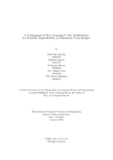A comparison of deep learning U‐Net architectures for semantic segmentation on panoramic X-ray images
Abstract
Digital image processing utilizes deep learning to tackle challenging issues such as
image colourization, classification, segmentation, and detection. The medical image
analysis field is developing day by day, and segmenting organs, diseases, or abnor malities is a challenging task to complete. Dental disease diagnosis is one of these
fields where image segmentation can help gain significant improvements as dentists
worldwide face various problems in diagnosing dental diseases with the naked eye.
Compared to other medical images, dental radiographic images provide multiple
challenges in terms of processing, making segmentation a more complex task. Deep
neural network models are used more frequently for various image segmentation ap plications. U-Net is one such model. Multiple variations and advancements have
been created for this network model to serve better performance, mainly on seman tic segmentation of medical images. However, comparative studies must determine
how well these variants perform in segmenting dental x-ray images. This research
uses six U-Net architecture (Vanilla U-net, Dense U-net, Attention U-net, SE U net, Residual U-net, R2 U-net) variants for segmenting dental radiographic X-rays
that are extensively and effectively compared. Some U-Net architectural variations
under consideration still need to be evaluated for segmenting dental radiographic
X-rays. For all architectures, we used 2 and 3 convolutional layers. We used four
types of matrices to compare the models: Accuracy, Dice coefficient, F1 score and
IoU. Among the variants, Vanilla-unet with two convolutional layers provided the
best Accuracy of 95.56% and IoU score of 88% on the validation set for much lesser
time than other architectures. On the other hand, when we use three convolutional
layers, dense-unet provides the best Accuracy of 95.94% and IoU score of 89.07%
on the validation set. However, most of the examined architectures throughout the
dataset showed minor changes when segmentation performance was measured using
all four accuracy metrics. This study indicates that U-Net is enough for radio graphic X-ray segmentation. Choosing simpler models will save time and money
during testing and model creation. Therefore, our suggested approach might aid in
making automated dental disease diagnosis models.

